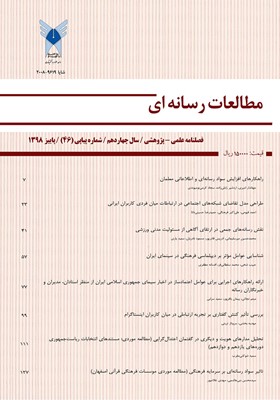تحلیل مدارهای هویت و دیگری در گفتمان اعتدالگرایی (مطالعه موردی: مستندهای انتخابات ریاستجمهوری دورههای یازدهم و دوازدهم)
محورهای موضوعی : مدیریت رسانه
1 - دانشجوی دوره دکتری زبانشناسی همگانی، دانشگاه شیراز
کلید واژه: تحلیل گفتمان (انتقادی), حسن روحانی, هویت (خود و دیگری), مستندهای تبلیغات انتخاباتی, انتخابات ریاست جمهوری 1392 و 1396,
چکیده مقاله :
این پژوهش بر آن است تا با نگاهی تطبیقی، چگونگی بازنمایی هویت در مستندهای تبلیغاتی گفتمان اعتدالگرایی را در دو دوره انتخابات ریاست جمهوری یازدهم و دوازدهم در خرداد 1392 و اردیبهشت 1396 واکاوی نماید. نوشتار پیش رو بهگرد این پرسش میگردد که: در جریان مبارزات انتخابات ریاستجمهوری یازدهم و دوازدهم، هویت چگونه در مستندهای انتخاباتی نامزد هژمونشده، مفصلبندیشده و با کاربست چه نشانگان، مولفهها و فرایندهایی تولید و بازتولید شده است؟ در مقام پاسخ، این مدعا میآید که در جریان این دو دوره انتخابات ریاستجمهوری، گفتمان پیروز تبلیغات خود را بر مبنای نمایش صورتبندی ایدئولوژیکی خاص خود مفصلبندی کرده است که در بافتار آن، خود و دیگری بهگونهای ویژه، در سایه دال کانونی مطرح و مرزهای گفتمان بهگونهای ایجابی و سلبی نمایان میشود. مبنای نظری پژوهش برپایه تعریف سه سطح طراحی شد. سطح خرد مبتنی بر سازوکارهای زبانی مانند دلالت صریح و ضمنی و پیوندهای بینامتنی است. در سطح میانی مفاهیم از راه کندوکاو زبانی حاصل و بهمنظور دستیابی به مفاهیم کلان از رهیافت گفتمانی لاکلا و موف و نورمن فرکلاف استفاده میشود. برمبنای یافتهها گفتمان اعتدالگرایی در هر دو دوره انتخابات ریاست جمهوری با ابتنای بر رویکردی سلبی و دگرسازانه، به ترسیم مرزهای هویت خود پرداخته و با استفاده از ابزار حاشیهرانی، خود را بهصورتی مثبت بازنمایی میکند.
This study is about to comparatively investigate how identity is represented in the campaign films of the 11th and 12th presidential elections in June 2013 and May 2017. This study is based on a question that “in the process of the 11th and 12th presidential elections, how identity is articulated in the campaign films of the hegemon candidate and it has been produced and reproduced with what kind of signifiers, elements and processes?” In order to answer this question this claim is proposed that in the process of the two periods of the presidential elections, the elected discourse has articulated his campaigns on the base of presenting a special formulation of its ideology in the context of which self and other are presented in a special way in the shade of the nodal signifier and reflect their borderlines with other discourses positively or negatively. The theoretical base and the methodological framework of this research are planned on defining three levels. The micro-level is based on linguistic mechanisms like explicit and implicit implication and intertextuality. In the middle level, concepts are gained through linguistic investigations and in order to reach the macro concepts, the approaches of Laclau and Mouffe and Norman Fairclough have been used. According to the findings, the Moderationist discourse in both of its presidential campaigns, being based on negative and other-making approach drew its identity borders and through backgrounding, positively represents itself.
_||_

